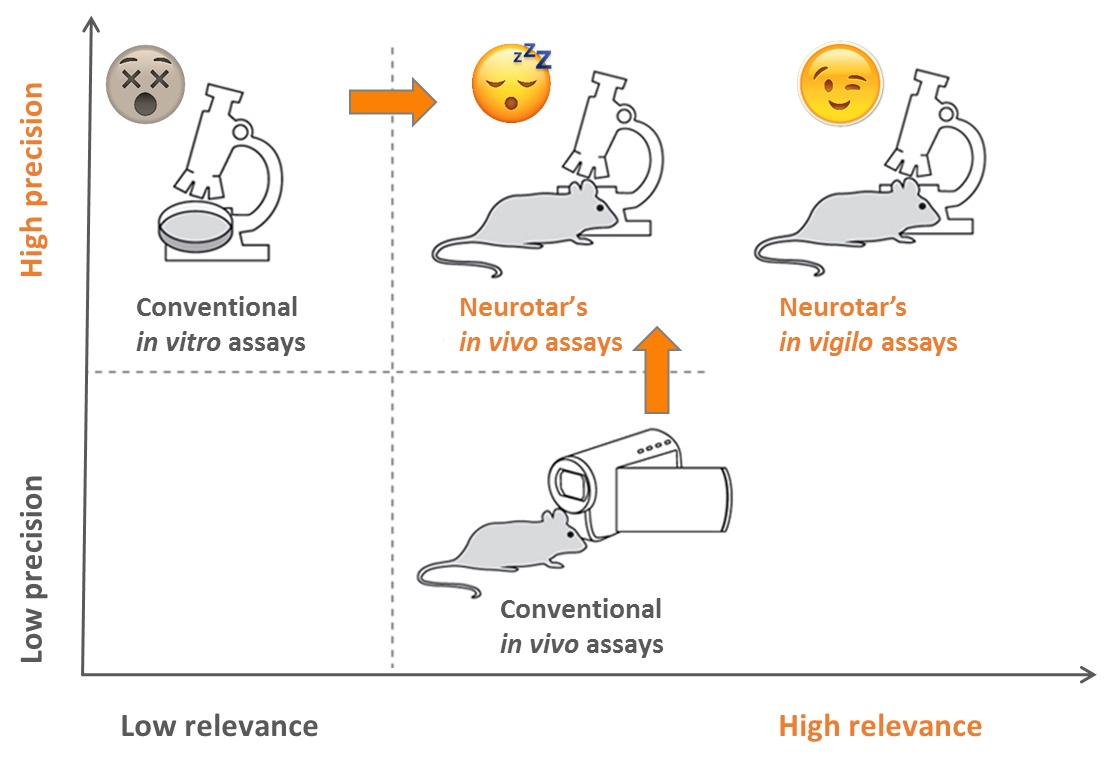The CNS is the graveyard of drug development
Consider the numerous recent CNS (Central Nervous System) drug failures (often in late clinical phases), the small number of new drugs entering the market, and the large number of pharmaceutical companies downsizing or disbanding their CNS development programs.
What causes high failure rates?
- The inability of drug candidates to cross the blood-brain barrier
- Lack of efficacy
- The use of non-optimal preclinical models.
Why not try something new?
Test your lead molecules in the best preclinical model: the brain of a living mouse.
Two-photon image of Layer V neurons of the cortex in Thy1-YFP mouse
Why choose the in vivo brain imaging services at Neurotar®?
Conventional in vitro microscopy offers excellent opportunities for live cell imaging with high spatial and temporal resolution. However, the relevance of assays with dissociated cells or tissue slices is limited as they lack the complex environment of a living brain, and they provide a very limited time horizon.

Conventional imaging assays in live animals, such as PET, CT, and (f)MRI, allow longitudinal follow-up of the intact brain. Unfortunately, these techniques have a low spatial resolution.
With Neurotar® imaging assays, you get the best of both worlds. Using two-photon brain imaging in live mice, we obtain high-resolution imaging data of high physiological and disease relevance. We follow disease progression and effects of treatment longitudinally and with sub-cellular resolution. To read more about two-photon imaging and why it is the superior choice for functional brain imaging, please visit our two-photon microscopy page.
General anesthetics, such as the commonly used ketamine, affect several neurological processes in the brain, including dendritic spine turnover and microglial activity. Fortunately, at Neurotar we can perform two-photon imaging studies in awake, behaving mice (in vigilo) using our proprietary Mobile HomeCage®. Through a combination of stable head fixation and a flat-floored air-lifted cage, the Mobile HomeCage enables precise brain imaging in awake mice that move around in 2D. The Mobile HomeCage® makes it possible to integrate in vivo imaging with behavioral observation.
Advantages of Neurotar® two-photon microcopy
● High imaging depth (up to 1 mm)
● High resolution (down to organelle level)
● Low phototoxicity
● Long longitudinal follow-up (up to several months)
● Reduced variability as each animal is its own control
● Fewer animals per treatment group
● Perform in vivo imaging studies in awake, behaving mice
● Integrate in vivo imaging with behavioral observation
● In line with the industry’s imperative to refine, reduce and, whenever possible, replace animal experimentation
How can Neurotar® aid your drug development?
At Neurotar, we offer a broad portfolio of disease-relevant in vivo two-photon imaging services. Follow the links below for more information about specific imaging assays:
| Neurodeg. Disease (e.g. AD, PD) | Stroke and TBI | Neuropathic Pain and Migraine | Neuropsychiatry (e.g. Schizophrenia) | Epilepsy | |
|---|---|---|---|---|---|
| Blood-brain barrier integrity | ✓ | ✓ | ✓ | ||
| Trans-BBB pharmacokinetics | ✓ | ✓ | ✓ | ||
| Dendritic spine turnover | ✓ | ✓ | ✓ | ✓ | ✓ |
| Microglial dynamics or response to injury | ✓ | ✓ | ✓ | ✓ | ✓ |
| Calcium signaling | ✓ | ✓ | ✓ | ✓ | ✓ |
| Abeta Plaque or Tau Tangle dynamics | ✓ | ✓ | ✓ | ||
| Mitochondrial fragmentation | ✓ | ✓ | ✓ | ✓ | ✓ |
| Ischemic Stroke model | ✓ | ||||
| Regeneration of peripheral neurons | ✓ | ✓ | ✓ |
When to contact us?
- Customers usually engage us at the lead selection or lead optimization phases of preclinical drug development.
- We can also contribute to the development or assessment of mouse models.
Other benefits of engaging with Neurotar®
Neurotar® is the world’s leading commercial service provider of in vivo two-photon brain imaging in mice.
When you engage with Neurotar, you work with a team of highly dedicated experts. We share a passion for neuroscience and two-photon brain imaging in live mice. Since 2012, we have completed over 70 in vivo two-photon brain imaging projects for more than 30 pharmaceutical and biotechnology companies from around the globe. Through this experience, we have gained valuable technical expertise & insights into the inner workings of the brain. We have also accumulated industry knowledge inaccessible to conventional CROs. For longitudinal microscopic imaging of live rodent brains, you have found the right place.